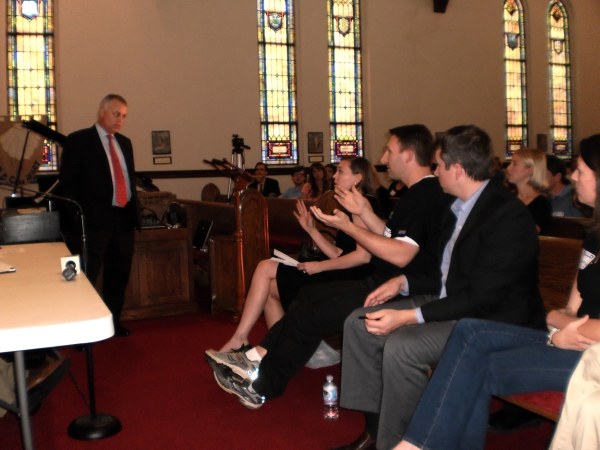Superintendent Tony Tata met with about 100 parents at a church in downtown Raleigh’s Oakwood neighborhood Monday night to address concerns about a lack of school capacity.
The meeting comes after 223 families who participated in the first round of the new assignment plan’s choice process were not assigned to any of their five choice schools due to capacity constraints.
“We’ve been asking everyday: ‘how do we deal with these capacity issues?’ You need more seats downtown and we need to provide them for you,” Tata told parents.
While he recognized the need for more capacity, Tata wasn’t able to present a short-term solution that satisfied parents.
“It’s wonderful that so many families have gotten their choice. I recognize that, but it is unfair for us families who got none of our five choices,” said John Boyne, a downtown resident. “Can immediate action be taken? To be asked to wait and see is not comforting.”
As a conciliatory gesture, the school system is allowing unassigned parents to participate in the second choice round without it affecting their first round choices. That means they will remain on a waitlist and their first and second round choices will both be considered.
“That’s not happening for anybody else,” Tata said.

Raleigh parents voice their frustrations to Superintendent Tony Tata Monday night during a meeting to discuss school assignment. Photo by Will Huntsberry.
All other families who participate in the choice process give up their seat or place on a waitlist.
During the second choice round, families who were unassigned will also have their list of choice schools expanded from five to seven.
“I’ve heard you say you’ll seat us and I’ve heard you say you’ll seat us at one of our five schools,” one parent said. “If I listed five schools do I get one of those schools?”
Tata deferred the question to Chief Transformation Officer Judy Peppler, who couldn’t make any guarantees.
“We are going to do everything humanly possible to get you an assignment from your original list,” she said. “If we can’t, we will contact you individually to look through your options.”
Several disgruntled parents who attended the meeting received a school assignment after participating in the first round, but, because of capacity constraints, it was in their fourth or fifth choice.
Julia Kirkpatrick’s child received her fifth choice.
“We would have been thrilled with our first three [choices], perhaps even our fourth choice,” she said.
Kirkpatrick suggested that because the assignment algorithm puts priority on students getting their first choice—rather than their first or second—a fallout may be occurring on the back end that is causing more people to get stuck in their fourth- and fifth-choice schools.
Another downtown resident, Elliot Poger, who works as a programmer for Google, stepped in to offer advice.
“You could rebalance choice one and two [so not all of the priority is given to receiving your first choice]. That would optimize happiness,” Poger said.
One way Poger suggested such an algorithm might work is for parents to not only rank their five choices, but rank their satisfaction level with each choice as well.
“For instance, I’m 10 happy at my first choice and eight happy at my second choice,” he said.
Other suggestions from the crowd included a pre-registration program for pre-school aged children and setting aside one school in each region, which would be designated to take all students that weren’t assigned.
Long-Term Problem
As reported in Monday’s Record article, Raleigh is experiencing a disparity in its massive growth and the relatively few number of schools that have been built in the city limits.
“There could not have been appropriate planning if you have this kind of a problem in an area where there’s a historically stable population,” said school board member Jim Martin, referring to the Oakwood and Mordecai neighborhoods, which he represents.
Tata said he and his team are working hard to find options for school space in central Raleigh. One option he mentioned was finding space for elementary programs on college campuses. Tata said the lack of space is a problem he’ll be bringing before the board for action soon.
Currently, there are no concrete plans for schools in central Raleigh, except for two single-sex leadership academies.
While Tata was unsure of how the school system could build more in central Raleigh, he said he had learned one definite lesson from the families who are unassigned.
“The magnet percentages need to be expanded,” he said in reference to the Group 1 magnet schools, which are close to many of the unassigned families’ residences.
Currently, Group 1 magnets are made up of 60 percent proximity students and 40 percent “magnet” students, who live outside the area. Tata said his team will look at raising the percentage of proximity students to as high 80 percent in those schools to provide more capacity.
Tata summed up his new assignment plan for parents like this: “When you look at it at it from a macro, system wide perspective the plan is working. When you look at it in this church it is not working.”
